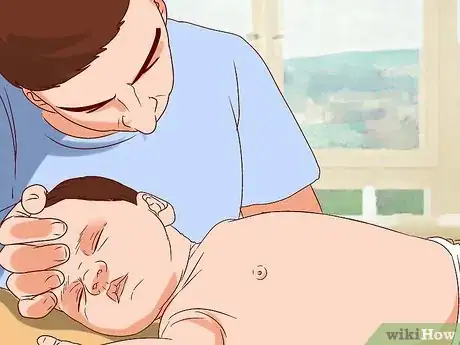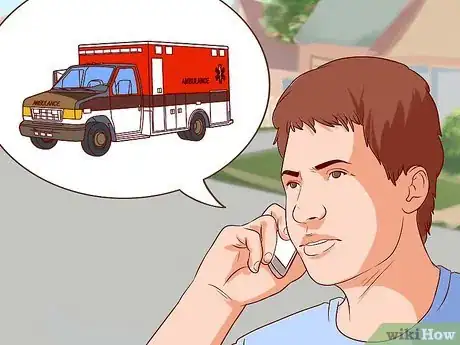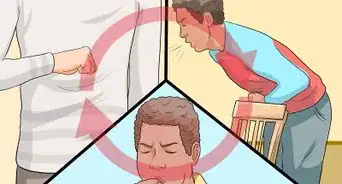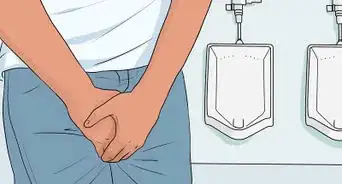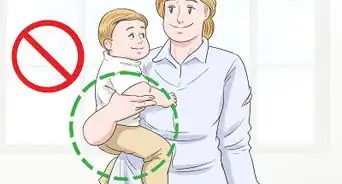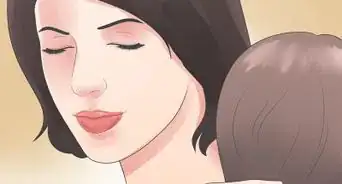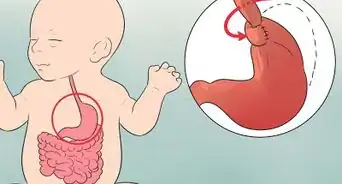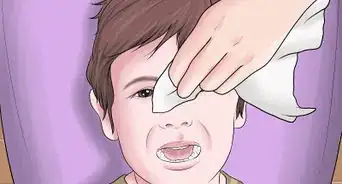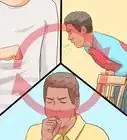This article was co-authored by Laura Marusinec, MD. Dr. Marusinec is a board certified Pediatrician at the Children's Hospital of Wisconsin, where she is on the Clinical Practice Council. She received her M.D. from the Medical College of Wisconsin School of Medicine in 1995 and completed her residency at the Medical College of Wisconsin in Pediatrics in 1998. She is a member of the American Medical Writers Association and the Society for Pediatric Urgent Care.
This article has been viewed 148,710 times.
A choking baby (infant) is every parent's nightmare but knowing what to do will allow you to be immediately responsive should this ever happen to you. While the Heimlich maneuver is used for choking adults and older children, you actually don't use the Heimlich maneuver on babies — instead, you perform a series of strikes while the baby is turned face-down.
Steps
Reacting Quickly
-
1Determine if the baby can cough. The first thing to do when you see a baby struggling to breathe is check whether she can cough or make sounds. If she can cough firmly, then let her cough to try and dislodge the object that is obstructing her breathing. If you are worried about her breathing and she cannot dislodge the object through coughing you should call for emergency medical help.[1]
- If your baby can cough forcefully or cry strongly do not attempt the following steps to dislodge it. Instead, monitor her closely until you know the blockage has been dislodged. Be ready to act if the symptoms worsen and persist.[2]
-
2Check if the baby is breathing. If the baby cannot cough, cry, or make any sounds or at all, you should immediately check if he is breathing. Danger signs for choking also include your baby having only a weak and ineffective cough, or only making soft high-pitched sounds when he breathes in. Look to see if the baby is turning blue, losing consciousness, or is waving his arms desperately without making any sound; quickly check his chest to see if it's moving up and down, and listen for breathing sounds.[3]
- If you can see the obstruction in the baby's mouth or throat and it is easily accessible you can remove it, but do not feel around in the baby's throat. You risk pushing the obstruction in further.[4]
- You should not try to grab and pull out the obstruction if the baby is conscious.[5]
- If the baby is unconscious, remove any visible objects from the mouth and begin CPR until the ambulance arrives. Be aware that there may be resistance to inflation initially until the stuck object is removed.
Advertisement -
3Call Emergency Services. If a baby is choking you should call emergency services before you begin to administer first aid. If possible, ask someone else to make the call, as you start to clear the baby's blocked airway. If you are alone, shout for help but don't leave the baby and be sure to continue to administer first aid. If your baby has been choking, you should always call your doctor afterwards. Do this even if the obstruction has been removed and she appears to be breathing normally.[6]
Dislodging the Airway Obstruction
-
1Prepare to give back blows. If your baby is struggling to breathe, or has stopped breathing you need to act quickly to dislodge the object which is obstructing his airway. The first technique to use is back blows. Turn the baby face down on your lap for the back blows. Hold the baby in this secure face-down position and be sure to support the baby's head. The front of the baby is supposed to be firmly leaning against your arm, and you can use your thigh for support.[7]
- Ensure that you are not covering the baby's mouth or twisting his neck.
- The baby's head should be slightly lower than her chest.[8]
-
2Give five firm back blows. Once you have positioned the baby you need to administer five firm but gentle back blows. Slap the baby's back, between her shoulder blades, with the heel of your hand five times. After five slaps, stop and check the baby's mouth to see if the blockage has become dislodged. If there is an obvious blockage which you can see and reach, carefully take it out. Do not do this if you risk pushing it further in.[9]
- If, after administering five back blows, the baby's airway has not been cleared, you will need to perform five chest thrusts.
-
3Prepare to perform chest thrusts. If your baby is coughing and crying, then it's a good sign, because this means some air is coming through. If the baby is not crying after the previous step and the object has not been visibly coughed up, then the back blows were unsuccessful. In this case, it's time to perform chest thrusts. Place the baby facing upwards across your lap, with the head lower than the body. Use your thigh or lap for support and be sure to support the head.[10]
-
4Give five chest thrusts. Once the baby is positioned and supported on your lap you need to perform five chest thrusts. Place two fingers on the centre of his breastbone, just below the nipples, or about one finger's breadth below the nipples. Then give five quick thrusts down.[11] The force you exert should compress the chest between a third and a half of its depth.[12]
- Check if the blockage has been dislodged and if it is easy for you to take it out do so, but again, do not risk pushing it in further.
- Continue to perform back blows and chest thrusts in this cycle until the blockage has been removed or until help arrives.[13]
- If the object has not been dislodged after three cycles of back blows and chest thrusts be sure to call emergency services immediately, if you haven't already.[14]
-
5Monitor your baby after the airway is cleared. Even after the object has been dislodged you should pay close attention to your baby. It is possible that some of the substance which caused the blockage may remain and cause problems in the near future. If she has any trouble swallowing, or has a persistent cough, you should seek medical help immediately. Take your child to see your doctor or to your local Hospital, or Emergency Room.[15]
Warnings
- Never perform these movements on a baby who is not choking.⧼thumbs_response⧽
- Don't perform abdominal thrusts (the actual Heimlich Maneuver) on a baby under one year old.⧼thumbs_response⧽
References
- ↑ http://www.webmd.com/first-aid/tc/choking-rescue-procedure-heimlich-maneuver-baby-younger-than-1-year
- ↑ http://www.nlm.nih.gov/medlineplus/ency/article/000048.htm
- ↑ http://www.nlm.nih.gov/medlineplus/ency/article/000048.htm
- ↑ http://www.babycentre.co.uk/a9298/first-aid-for-choking-an-illustrated-guide
- ↑ http://www.nlm.nih.gov/medlineplus/ency/article/000048.htm
- ↑ http://www.nlm.nih.gov/medlineplus/ency/article/000048.htm
- ↑ http://www.nhs.uk/chq/Pages/2300.aspx
- ↑ http://www.webmd.com/first-aid/tc/choking-rescue-procedure-heimlich-maneuver-baby-younger-than-1-year
- ↑ http://www.nhs.uk/chq/Pages/2300.aspx
- ↑ http://www.nlm.nih.gov/medlineplus/ency/article/000048.htm
- ↑ http://www.nhs.uk/chq/Pages/2300.aspx
- ↑ http://www.nlm.nih.gov/medlineplus/ency/article/000048.htm
- ↑ http://www.nhs.uk/chq/Pages/2300.aspx
- ↑ http://www.redcross.org.uk/What-we-do/First-aid/Baby-and-Child-First-Aid/Choking-baby
- ↑ http://www.nhs.uk/chq/Pages/2300.aspx
About This Article
Before you perform the Heimlich maneuver on a baby, check to see if they're forcefully coughing or crying. If they are, do not attempt to dislodge the object in their throat yourself, since they should be able to dislodge it on their own. However, if they're not able to forcefully cough or cry, call for emergency medical help immediately. Then, turn the baby face down on your lap so their head is slightly lower than their chest, and slap their back between their shoulder blades 5 times with the heel of your hand. If the object is still not dislodged, place the baby face up in your lap with their head lower than their body. Then, place 2 fingers on the center of their breastbone, and give 5 quick thrusts down. Continue to alternate between back blows and chest thrusts until the object has been dislodged. For advice from our Medical co-author, like how to safely remove a lodged object using your fingers, keep reading.

